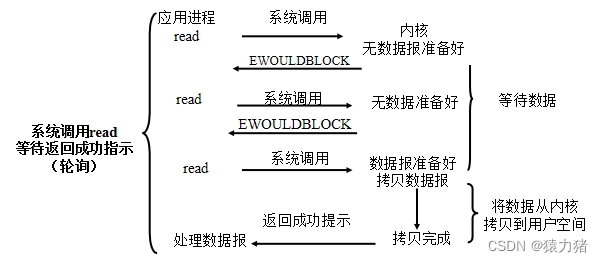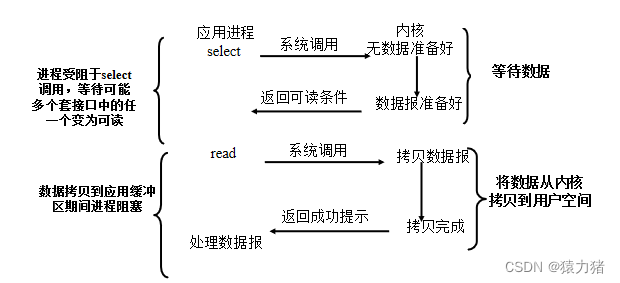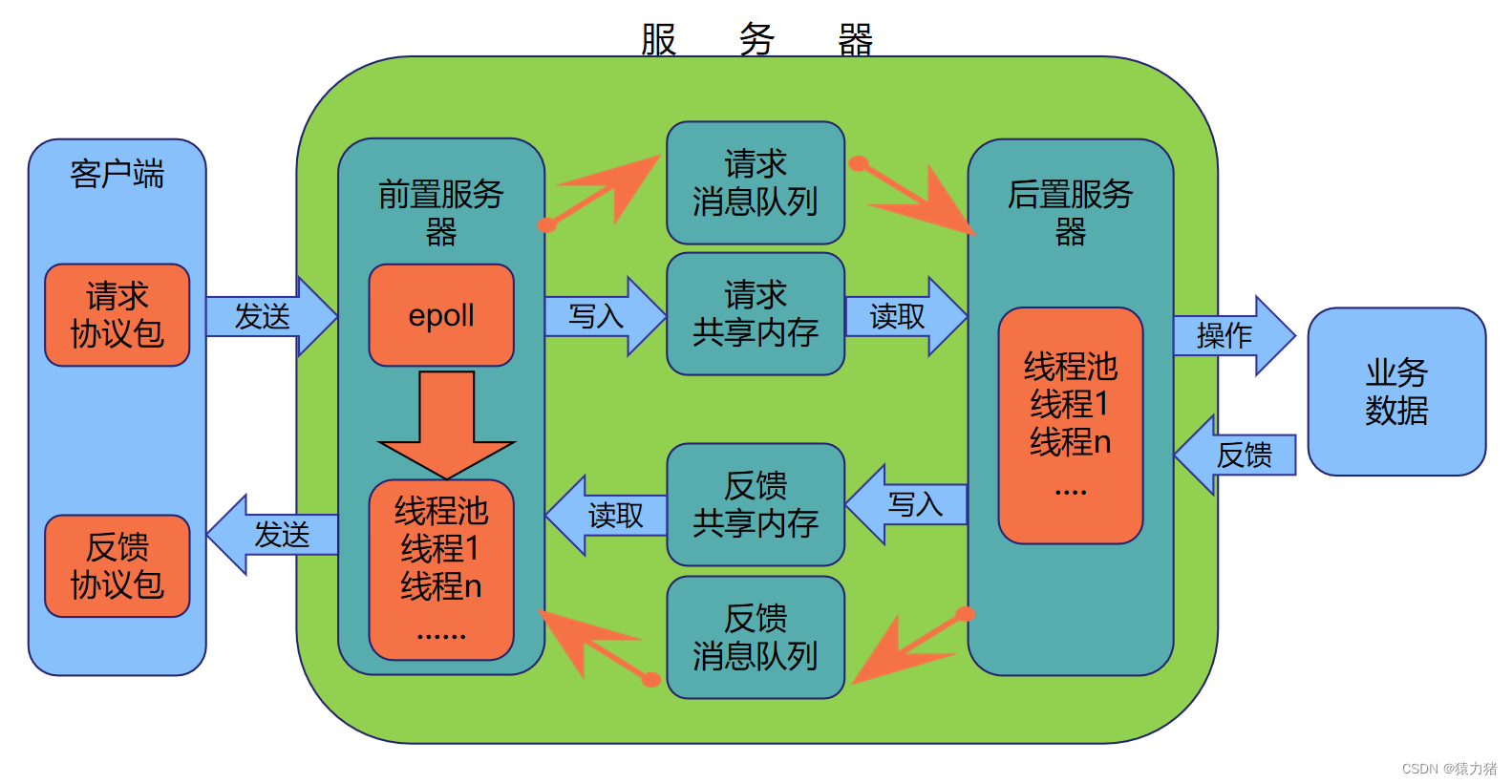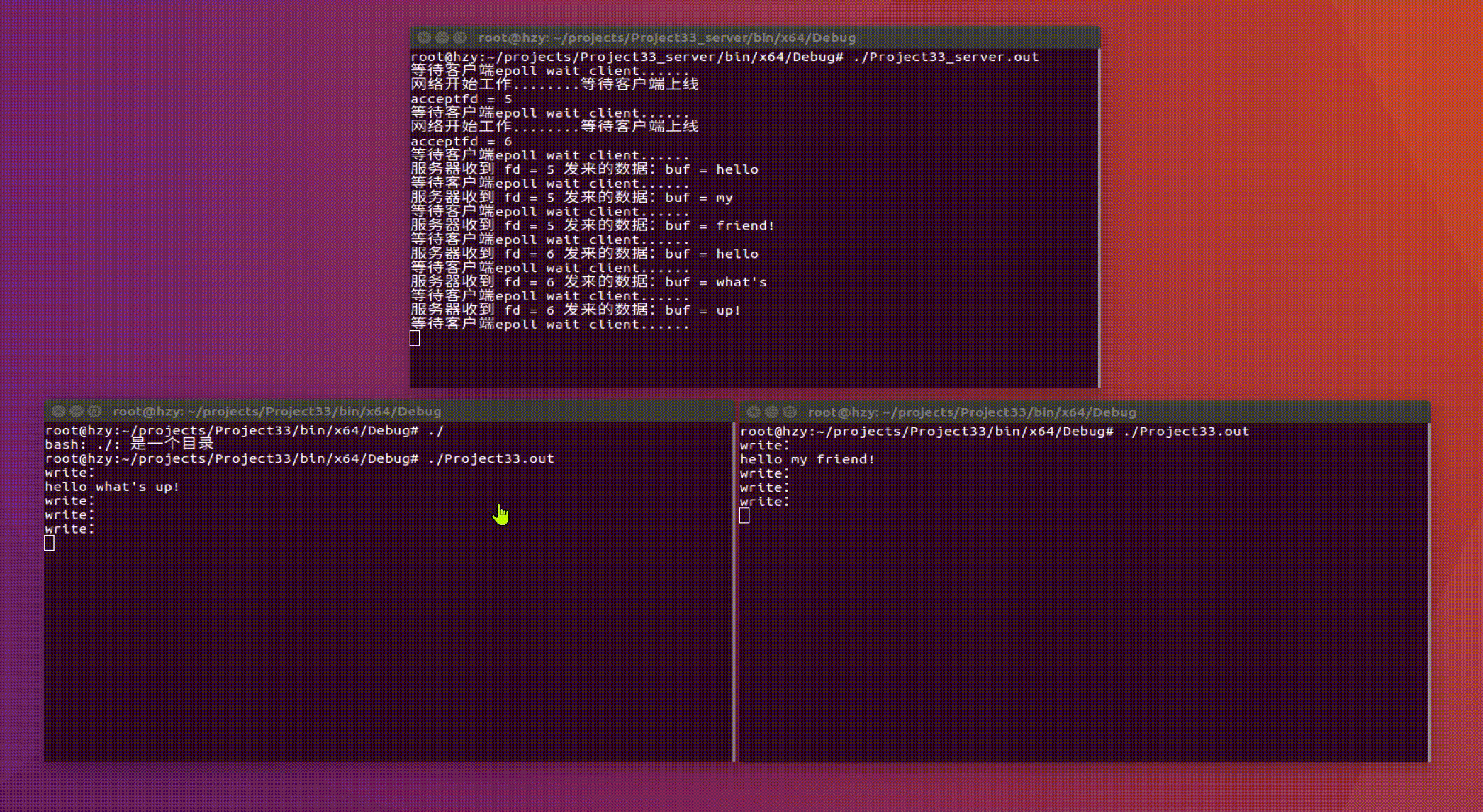目录
前言
一、IO复用基本概念
💻阻塞I/O
💻非阻塞I/O
💻I/O复用
📌select 函数
📌poll 函数
📌epoll 函数
二、利用I/O复用搭建服务器/客户端
💻服务器完整代码
💻客户端完整代码
💻测试效果
前言
本文主要学习Linux内核编程,结合Visual Studio 2019进行跨平台编程,内容包括IO复用技术相关知识介绍以及用服务器客户端实例说明(详细举例epoll的使用 )
一、IO复用基本概念
💻阻塞I/O
最流行的I/O模型是阻塞I/O模型,缺省时,所有的套接口都是阻塞的

💻非阻塞I/O
当我们把一个套接口设置为非阻塞方式时,即通知内核,当请求的I/O操作非得让进程睡眠不能完成时,不要让进程睡眠,而应返回一个错误
应用程序连续不断地查询内核,看看某操作是否准备好,这对CPU时间是极大的浪费,一般只在专门提供某种功能的系统中才会用到

💻I/O复用
有了I/O复用,我们就可以调用select或poll,在这两个系统调用的某一个上阻塞,而不是真正阻塞于真正的I/O系统调用
如果一个或多个I/O条件满足(例如:输入已准备好被读,或者描述字可以承接更多输出的时候)
我们就能够被通知到,这样的能力被称为I/O复用,是由函数select和poll支持的

I/O复用网络应用场合:
- 当客户处理多个描述字
- 一个客户同时处理多个套接口
- 如果一个TCP服务器既要处理监听套接口,又要处理连接套接口
- 如果一个服务器既要处理TCP,又要处理UDP
📌select 函数
select函数允许进程指示内核等待多个事件中的任一个发生,并仅在一个或多个事件发生或经过某指定的时间后才唤醒进程
📍头文件:
📍作用: 提供了即时响应多个套接的读写事件
📍原型:
int select(int maxfdp1,fd_set *readset,fd_set *writeset,fd_set *except,
const struct timeval *timeout);
📍参数:
maxfdp1: 等待最大套接字值加1(等待套接字的数量)
readset:要检查读事件的容器
writeset:要检查写事件的容器
timeout: 超时时间
📍返回值: 返回触发套件接字的个数
📌poll 函数
poll函数和select类似,但它是用文件描述符而不是条件的类型来组织信息
也就是说,一个文件描述符的可能事件都存储在struct pollfd中
与之相反,select用事件的类型来组织信息,而且读,写和错误情况都有独立的描述符掩码
poll函数是POSIX:XSI扩展的一部分,它起源于UNIX System V
📍头文件:
📍作用: 提供了即时响应多个套接的读写事件
📍原型:
int poll(struct pollfd *fdarray,unsigned long nfds,int timeout);
📍参数:
fdarray:是一个pollfd的机构体数组用来表示表示文件描述符的监视信息
nfds:给出了要监视的描述符数目
timeout:是一个用毫秒表示的时间,是poll在返回前没有接收事件是应等待的时间,如果timeout的值为-1,poll就永远不会超时,如果整数值为32个比特,最大超时周期约为30分钟
📍返回值:准备好描述字的个数,0-超时,1-出错
📌epoll 函数
epoll是基于事件驱动的I/O方式,相对于select来说 ,epoll没有描述符个数限制,使用一个文件描述符管理多个描述符, 将用户关心的文件描述符的事件存放到内核的一个事件表中, 这样在用户空间和内核空间的copy只需一次

Linux中提供的epoll相关函数如下:
🎮epoll_create ()
📍作用:创建一个epoll句柄
📍原型:
int epoll_create(int size);
📍参数:
size:表明内核要监听的描述符数量
📍返回值:成功时返回一个epoll句柄描述,失败时返回-1
🎮epoll_ctl ()
📍作用:注册要监听的事件类型
📍原型:
int epoll_ctl(int epfd, int op, int fd, struct epoll_event *event);
📍参数:
epfd:表示epoll句柄
op:表示fd操作类型,有如下3种
EPOLL_CTL_ADD 注册新的fd到epfd中
EPOLL_CTL_MOD 修改已注册的fd的监听事件
EPOLL_CTL_DEL 从epfd中删除一个fd
fd:是要监听的描述符
event:表示要监听的事件
📍返回值:成功时返回 0,失败时返回-1
🎮epoll_wait()
📍作用:等待事件的就绪,成功时返回就绪的事件数目
📍原型:
int epoll_wait(int epfd, struct epoll_event * events, int maxevents, int timeout);
📍参数:
epfd:是epoll句柄
events:表示从内核得到的就绪事件集合
maxevents:告诉内核events的大小
timeout:表示等待的超时事件
📍返回值:调用失败时返回 -1,等待超时返回 0
二、利用I/O复用搭建服务器/客户端
代码参考自博主:似末
链接:【Linux】一文看懂多路复用IO模型(select、poll、epoll)_似末的博客-CSDN博客
💻服务器完整代码
#include
#include
#include
#include
#include
#include
#include
#include
#include
#include
using namespace std;
int main()
{
int socketfd = 0;
int acceptfd = 0;
struct sockaddr_in s_addr;
int len = 0;
char buf[255] = { 0 };//存放客户端发过来的信息
int opt_val = 1;
//初始化网络 参数一:使用ipv4 参数二:流式传输
socketfd = socket(AF_INET, SOCK_STREAM, 0);
if (socketfd == -1)
{
perror("socket error");
}
else
{
//原本使用struct sockaddr,通常使用sockaddr_in更为方便,两个数据类型是等效的,可以相互转换
struct sockaddr_in s_addr;
//确定使用哪个协议族 ipv4
s_addr.sin_family = AF_INET;
//系统自动获取本机ip地址 也可以是本地回环地址:127.0.0.1
s_addr.sin_addr.s_addr = inet_addr("192.168.48.128");
//端口一个计算机有65535个 10000以下是操作系统自己使用的, 自己定义的端口号为10000以后
s_addr.sin_port = htons(10086); //自定义端口号为10086
len = sizeof(s_addr);
//端口复用 解决 address already user 问题
setsockopt(socketfd, SOL_SOCKET, SO_REUSEADDR, (const void*)opt_val, sizeof(opt_val));
//绑定ip地址和端口号
int res = bind(socketfd, (struct sockaddr*)&s_addr, len);
if (res == -1)
{
perror("bind error");
}
else
{
//监听这个地址和端口有没有客户端来连接 第二个参数现在没有用 只要大于0就行
if (listen(socketfd, 2) == -1)
{
perror("listen error");
}
}
int epollfd = 0;
int epollwaitefd = 0;
struct epoll_event epollEvent;
struct epoll_event epollEventArray[5];
//事件结构体初始化
bzero(&epollEvent, sizeof(epollEvent));
//绑定当前准备好的sockedfd(可用网络对象)
epollEvent.data.fd = socketfd;
//绑定事件为客户端接入事件
epollEvent.events = EPOLLIN;
//创建epoll
epollfd = epoll_create(5);
//将已经准备好的网络描述符添加到epoll事件队列中
epoll_ctl(epollfd, EPOLL_CTL_ADD, socketfd, &epollEvent);
while (1)
{
cout << "等待客户端epoll wait client......" << endl;
epollwaitefd = epoll_wait(epollfd, epollEventArray, 5, -1);
if (epollwaitefd < 0)
{
perror("epoll wait error");
}
for (int i = 0; i < epollwaitefd; i++)
{
if (epollEventArray[i].data.fd == socketfd)
{
cout << "网络开始工作........等待客户端上线" << endl;
acceptfd = accept(socketfd, NULL, NULL);
cout << "acceptfd = " << acceptfd < 0)
{
cout << "服务器收到 fd = " << epollEventArray[i].data.fd << " 发来的数据:buf = " << buf << endl;
}
else if (res <= 0)
{
cout << "........客户端掉线........" << endl;
close(epollEventArray[i].data.fd);
//从epoll中删除客户端描述符
epollEvent.data.fd = epollEvent.data.fd;
epollEvent.events = EPOLLIN;
epoll_ctl(epollfd, EPOLL_CTL_DEL, epollEventArray[i].data.fd, &epollEvent);
}
}
}
}
}
}💻客户端完整代码
#include
#include
#include
#include
#include
#include
#include
#include
#include
#include
using namespace std;
int main()
{
int socketfd = 0;
int acceptfd = 0;
struct sockaddr_in s_addr;
int len = 0;
char buf[255] = { 0 };//存放客户端发过来的信息
int opt_val = 1;
//初始化网络 参数一:使用ipv4 参数二:流式传输
socketfd = socket(AF_INET, SOCK_STREAM, 0);
if (socketfd == -1)
{
perror("socket error");
}
else
{
//原本使用struct sockaddr,通常使用sockaddr_in更为方便,两个数据类型是等效的,可以相互转换
struct sockaddr_in s_addr;
//确定使用哪个协议族 ipv4
s_addr.sin_family = AF_INET;
//系统自动获取本机ip地址 也可以是本地回环地址:127.0.0.1
s_addr.sin_addr.s_addr = inet_addr("192.168.48.128");
//端口一个计算机有65535个 10000以下是操作系统自己使用的, 自己定义的端口号为10000以后
s_addr.sin_port = htons(10086); //自定义端口号为10086
len = sizeof(s_addr);
//端口复用 解决 address already user 问题
setsockopt(socketfd, SOL_SOCKET, SO_REUSEADDR, (const void*)opt_val, sizeof(opt_val));
//绑定ip地址和端口号
int res = bind(socketfd, (struct sockaddr*)&s_addr, len);
if (res == -1)
{
perror("bind error");
}
else
{
//监听这个地址和端口有没有客户端来连接 第二个参数现在没有用 只要大于0就行
if (listen(socketfd, 2) == -1)
{
perror("listen error");
}
}
int epollfd = 0;
int epollwaitefd = 0;
struct epoll_event epollEvent;
struct epoll_event epollEventArray[5];
//事件结构体初始化
bzero(&epollEvent, sizeof(epollEvent));
//绑定当前准备好的sockedfd(可用网络对象)
epollEvent.data.fd = socketfd;
//绑定事件为客户端接入事件
epollEvent.events = EPOLLIN;
//创建epoll
epollfd = epoll_create(5);
//将已经准备好的网络描述符添加到epoll事件队列中
epoll_ctl(epollfd, EPOLL_CTL_ADD, socketfd, &epollEvent);
while (1)
{
cout << "等待客户端epoll wait client......" << endl;
epollwaitefd = epoll_wait(epollfd, epollEventArray, 5, -1);
if (epollwaitefd < 0)
{
perror("epoll wait error");
}
for (int i = 0; i < epollwaitefd; i++)
{
if (epollEventArray[i].data.fd == socketfd)
{
cout << "网络开始工作........等待客户端上线" << endl;
acceptfd = accept(socketfd, NULL, NULL);
cout << "acceptfd = " << acceptfd < 0)
{
cout << "服务器收到 fd = " << epollEventArray[i].data.fd << " 发来的数据:buf = " << buf << endl;
}
else if (res <= 0)
{
cout << "........客户端掉线........" << endl;
close(epollEventArray[i].data.fd);
//从epoll中删除客户端描述符
epollEvent.data.fd = epollEvent.data.fd;
epollEvent.events = EPOLLIN;
epoll_ctl(epollfd, EPOLL_CTL_DEL, epollEventArray[i].data.fd, &epollEvent);
}
}
}
}
}
}💻测试效果
通过跨平台连接Linux进行测试,先打开服务器再打开两个客户端
PS:上面的为服务器,下面两个为客户端1和客户端2 ,如下图所示:
参考:
【Linux】一文看懂多路复用IO模型(select、poll、epoll)_似末的博客-CSDN博客
以上就是本文的全部内容啦!如果对您有帮助,麻烦点赞啦!收藏啦!欢迎各位评论区留言!!!







